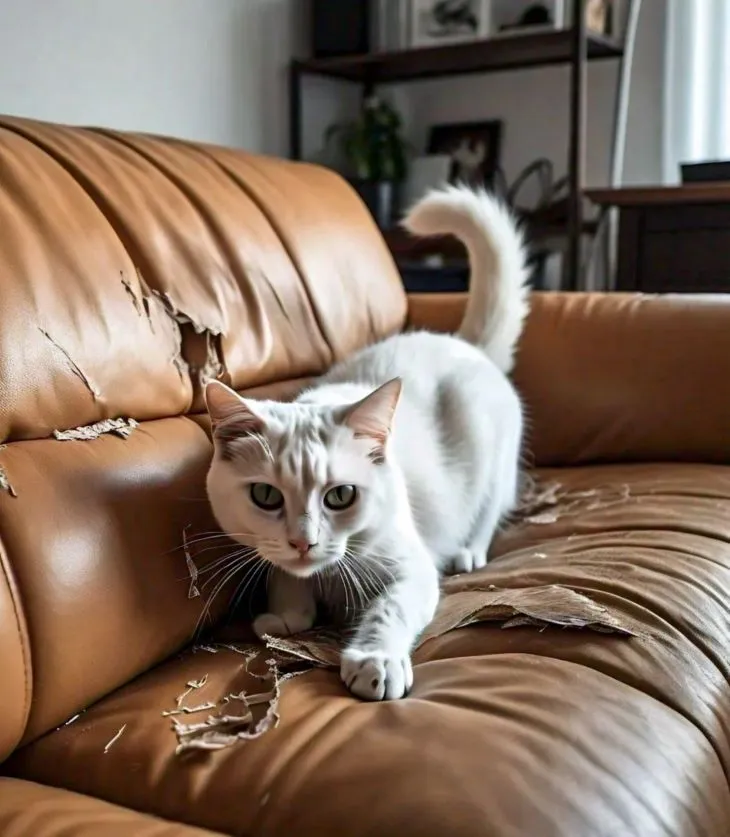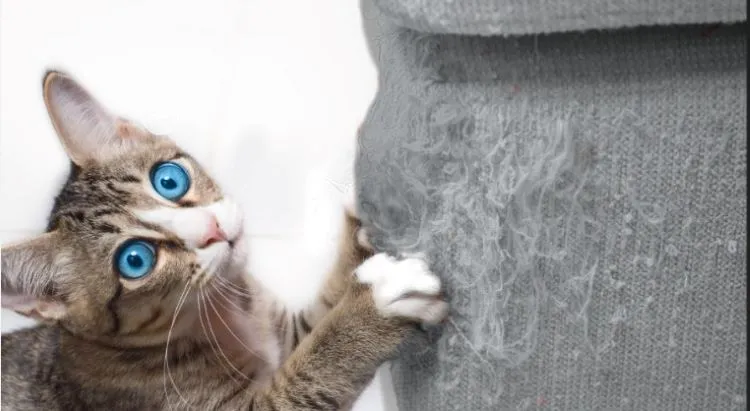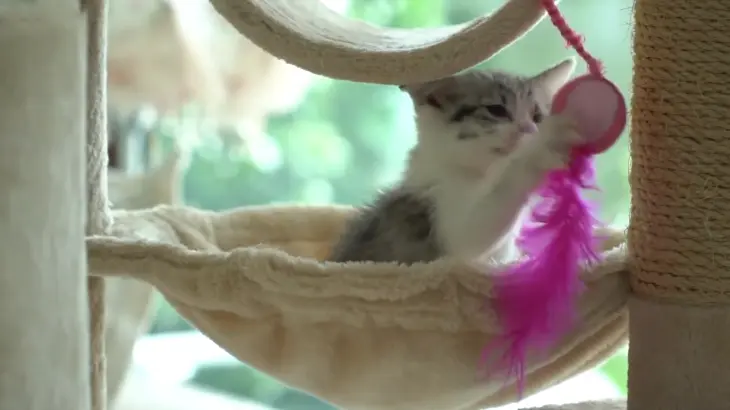How To Stop Cats From Scratching Furniture – Do’s & Don’ts
Stop cats from scratching furniture with Scratching Posts, Deterrents, and Positive Reinforcement. Learn effective solutions and what to avoid.
By: Dorris Abraham

The information in this article is intended to educate cat parents and is not a substitute for veterinary guidance. In case of any concerns about your cat’s health, please talk with your veterinarian.
Cats are lovable cute pets, but sometimes, their behavior can be surprising and frustrating for their owners. While activities like jumping, running, and climbing are considered normal for cats to a certain extent, they become a problem when they start damaging household items, particularly scratching furniture.
When faced with this issue, some cat owners turn to punishing their feline friends or even declawing them. However, these methods are cruel and ineffective in addressing the root cause of the problem.
If you find yourself in a situation where your cat is scratching your valuable furniture, going beyond its usual playful routine, it’s essential to understand the reasons behind this behavior.
Interesting read: Why Do Cats Knead?
Now, the question is how to create a harmonious environment that meets your cat’s needs and your desire to keep your furniture looking new. Let’s try to figure this out together in detail.
Why Do Cats Scratch Furniture?
Cats make great pets, but their scratching can damage furniture. Many owners find it hard to keep furniture looking nice. Let’s look at why cats scratch and how to help.

Scent Marking
When cats scratch things, they leave a special smell from their paws. This smell and the scratches they make let other cats know they were there. This is how cats “talk” to each other and show which areas belong to them. Your cat claims it as their own by scratching your carpets, sofas, or carpets.
Maintaining The Sharpness Of Their Claws
Another important reason cats scratch is to maintain the health and sharpness of their claws. Scratching helps cats remove the old outer layer of their claws, which can become dull or frayed over time. When this situation comes up, many cats like furniture because it’s tall and has smooth surfaces, which they find great for scratching.
Stretching And Exercising
Scratching helps cats stretch their bodies and stay active. When a cat scratches, they extend their body and flex their paws, which helps to keep them flexible and strong. This is especially important for indoor cats, who may not have as many opportunities to move and stretch as outdoor cats.
Scratching Out Of Boredom Or Stress
Sometimes, cats may scratch furniture simply because they’re bored, anxious, or stressed. Just like humans, cats can experience emotional distress, and scratching can be a way for them to cope with these feelings.
If your cat is scratching more than usual, it may indicate that they feel unsettled or need more stimulation. The question now is how to get cats to stop scratching things.
Click to learn: Why Do Cats Love Catnip?
How To Stop Cats From Scratching Furniture?
Scratched furniture can be a common problem for cat owners. Luckily, there are ways to stop cats from damaging your furniture. By understanding your cat’s needs, you can find effective solutions.

Provide Appropriate Scratching Surfaces
Get a good scratching post or pad to keep your cat from scratching your furniture. It should be big enough for your cat to stretch out and strong enough to use a lot. Look for posts made of materials that cats enjoy scratching, such as sisal rope, corrugated cardboard, or wood.
When picking a scratching post, think about what your cat likes. Some cats like to scratch things that are flat on the ground. Other cats like to scratch things that stand straight up.
Place Scratching Posts In Strategic Locations
Put the scratching post in a place where your cat likes to hang out a lot. This could be near their favorite sleeping spot, in the living room where they like to hang out, or near the furniture they’ve been scratching. By making the scratching post easily accessible and convenient, you’ll increase the chances that your cat will use it instead of your furniture.
Encourage Your Cat To Use The Scratching Post
To get your cat interested in their new scratching post:
- Try rubbing catnip or placing toys on it. You can softly move your cat’s paws to the post.
- When they scratch it, tell them they did a good job.
- Whenever you see your cat using the post, reward them with treats, petting, and verbal praise.

This positive reinforcement will help establish the scratching post as a desirable and rewarding place.
Make Your Furniture Less Appealing
In addition to providing alternative scratching surfaces, you can make your furniture less appealing to your cat. One way to do this is by covering the areas your cat likes to scratch with double-sided tape, aluminum foil, or plastic sheeting. Cats don’t like the feel of these materials on their paws, so they’ll be less likely to scratch there.
You can also use a feline-repellent spray on your furniture. These sprays contain scents that cats find unpleasant, such as citrus or menthol, and can help to deter them from scratching. Just be sure to test the spray on a small, inconspicuous area of your furniture first to ensure it doesn’t cause any damage.
Trim Your Cat’s Claws Regularly
Cutting your cat’s nails can also help make scratches less bad. You can do this using a pair of cat claw trimmers or take your cat to a groomer or veterinarian for a professional trim. Aim to trim your cat’s claws every two to four weeks, depending on how quickly they grow.
Consider Nail Caps
You may consider using nail caps if your cat still scratches your furniture despite your best efforts. These are little plastic caps that go on your cat’s claws. They stop your cat’s scratches from hurting things. Nail caps are also an alternative to declawing.
Provide Plenty Of Stimulation And Exercise
Boredom and lack of exercise can contribute to destructive scratching behavior in cats. To stop this, give your cat lots of toys to play with. Ensure they have time to play and chances to run around and check things out. This could include puzzle feeders, laser pointers, or interactive toys that encourage your cat to chase and pounce.
You can also try setting up a cat tree or climbing tower to give your cat a designated place to climb, scratch, and play. This can help to redirect their energy away from your furniture and provide them with a stimulating environment that meets their natural needs.
Work With A Cat Behavior Specialist
If you’ve tried multiple solutions and your cat is still scratching your furniture excessively, it may be time to consult a cat behavior specialist. These professionals can help you identify the underlying causes of your cat’s scratching behavior and develop a customized plan.
What Not To Do When Your Cat Scratches Furniture?
When your cat scratches furniture, it’s important to handle it properly. Some methods can be harmful or ineffective for your cat. Let’s explore what not to do when addressing this issue.
Don’t Declaw Your Cat
Many veterinarians and animal welfare organizations strongly oppose declawing and consider it to be an inhumane practice. Declawing removes the end part of a cat’s toes, which hurts the cat. It can cause long-term physical and behavioral problems, including chronic pain, difficulty walking, and increased aggression.
So, instead of declawing, focus on providing your cat with appropriate scratching surfaces and positive reinforcement training.
Don’t Punish Your Cat
Yelling at your cat, squirting them with water, or using other forms of punishment will not solve the scratching problem and may worsen it. Cats do not understand punishment in the same way humans do, and they may become fearful, anxious, or resentful.
The positive reinforcement approach is much more effective in the long run and will help to strengthen the bond between you and your cat.
Don’t Force Your Cat To Use A Scratcher
While it’s important to encourage your cat to use their scratching post, you should never force them to do so. Holding your cat down and making them scratch the post will only make them fear and avoid it in the future.
Instead, let your cat approach the scratching post on their terms and reward them with treats and praise when they use it. If your cat seems uninterested or hesitant, try rubbing catnip or placing toys on the post to make it more appealing.
Frequently Asked Questions
Conclusion
Scratching is a natural and necessary behavior for cats, but it doesn’t have to be frustrating for cat owners. Never use declawing or punishment as a solution to scratching. These inhumane and ineffective methods can cause long-lasting harm to your cat’s physical and emotional well-being.
Remember to choose a sturdy, appealing scratching post, place it conveniently, and encourage your cat to use it with positive reinforcement. If your cat’s scratching behavior persists despite your best efforts, don’t hesitate to seek the guidance of a cat behavior specialist.
